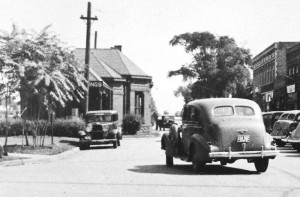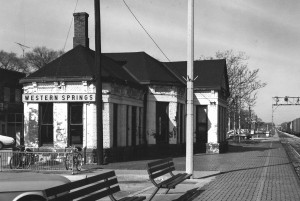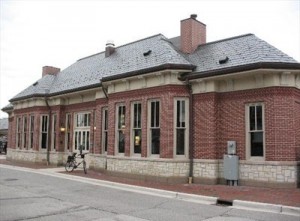In 1971, village officials decided to replace the brick and stone railroad station that had served the town since 1890. But, it wasn’t as easy as they had expected.

First Brick Train Station Before Modifications
Western Springs’ first railroad station was a small wooden depot located on the north side of the tracks near Wolf Road. However, as more people began to settle in the town, the Burlington Railroad decided to build a more substantial station on the south side of the tracks. So, in 1890, just four years after Western Springs was incorporated, a new $3,000 station was built where today’s station is located. The depot was built with red brick and had a gray slate roof. It also featured decorative “Tiffany brick” above the windows. As was common at that time, there were separate waiting rooms for men and women. The one for women was larger to also accommodate children, while the men’s area was smaller but allowed smoking.
Unfortunately, in 1890, city planners could not have anticipated the amount of vehicular traffic that would eventually utilize Burlington Avenue, which was adjacent to the station. In 1890, horses and wagons were the only conveyances and, except in the worst weather, most residents just walked to and from the downtown area. But, since the station extended six feet into Burlington Avenue, the growth of auto traffic became a major problem. So, in 1940, the railroad decided to remove the station’s south window bays to allow better traffic flow.

Station Just Prior to Demolition – 1972
Unfortunately, the alteration was very unattractive. As a result, the entire station was painted white to hide the masonry alterations. To make matters worse, the slate roof was removed and replaced with tin shingles. And, by 1971, the station had fallen into disrepair.
When the village proposed replacing it with a modern structure with large glass windows, residents formed a “Save Our Station” committee. Their goal was to preserve the old station as a historic landmark, as well as to avoid costly construction when less expensive renovations might suffice. They also opposed the village’s plan to relocate the station to the west, where they believed it would pose a major traffic and safety problem.
For well over a year, the group managed to keep the new station from going forward. They did cost studies to demonstrate that the old station could be rehabilitated for a fraction of what a new one would cost. They held an art show in which noted artist Charles Vickery entered a painting of what the station could look like if restored. And, they circulated petitions opposing the project.

New Railroad Station
Despite this, the Village Board went ahead with their plans. But, the large number of residents opposing the demolition exceeded the capacity of the Village Hall’s meeting room. As a result, Board meetings had to be held in another, larger location. But, despite presenting petitions signed by 1,527 residents, the Village President rebuffed their efforts, stating that the Board “… takes a dim view of petitions.” A new station would be built … period.
The station was subsequently demolished and replaced with a “modern” structure. But, ironically, the critics won out in the end. After just three decades of service, the new railroad station had become structurally unsound and had to be removed. And, what should replace it but a station patterned on the original 1890 depot.
